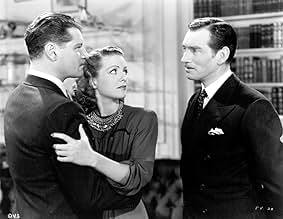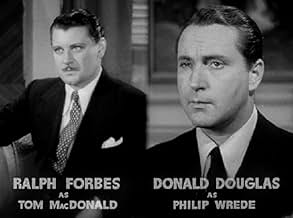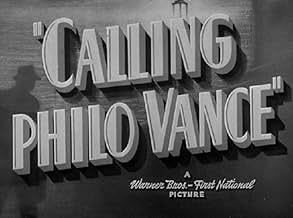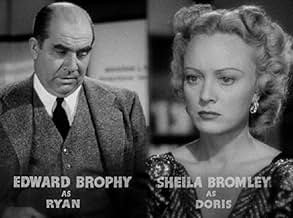Füge eine Handlung in deiner Sprache hinzuDespite an exclusive contract with the U.S. government, designer Archer Coe's design is being bid on by German, Japanese, and Italian agents - until he's murdered.Despite an exclusive contract with the U.S. government, designer Archer Coe's design is being bid on by German, Japanese, and Italian agents - until he's murdered.Despite an exclusive contract with the U.S. government, designer Archer Coe's design is being bid on by German, Japanese, and Italian agents - until he's murdered.
- Regie
- Drehbuch
- Hauptbesetzung
Jimmy Conlin
- Dr. Doremus - Coroner
- (as Jimmy Conlon)
Herbert Anderson
- First Reporter
- (Nicht genannt)
Henry Blair
- Hans Snauble
- (Nicht genannt)
Egon Brecher
- Austrian Judge
- (Nicht genannt)
Empfohlene Bewertungen
The main problem with this movie is that it is a remake of the 1933 the Kennel Murder Case, starring the incomparable William Powell. James Stephenson makes a passable attempt at playing Philo Vance, but without Powell's panache and humor. He would have made a better Bulldog Drummond. The plot is updated to Nazis and aviation secrets with a mysterious suicide? Murder? In the obligatory locked room. The supporting cast is as effective as most B movies, although Margot Stevenson lacks the fire and spirit of Mary Astor, who originated the role. It remains a moderately diverting movie. Be sure to catch William Hopper and George Reeves in early uncredited roles.
This remake of Kennel Murder Case, The (1933) has some good points, but James Stephenson is not one of them. He plays it too impersonal for my taste and pales by comparison with William Powell, who played Vance in the original. But the screenplay, which was updated for the war that loomed on the horizon, was nicely developed, concerning plans for a warplane. The setting was switched to the State Department, with Vance an employed investigator instead of a private eye. I really enjoyed how he used diagrams to explain the movement of the people involved in the murder of the warplane designer, so that in the end, the actions of all were clear. The film also had the advantage of having Edward Brophy in the Sergeant Heath role (here he's called Ryan), bringing comedy without the stupidity of the Heath character. It was rather fun to watch.
James Stephenson is Philo Vance in this movie. He's in Vienna, tracking down a rumor that Richard Kipling has been selling his military airplane designs to foreign governments, instead o the US, as he is required by contract to do so. Vance gets the plans, but they are taken from him by the local police. As a result, when he returns to the States, he reports to Henry O'Neill that he has no proof that would stand up in court. Stephenson and O'Neill go to Kipling's home, only to discover him dead bebehind a locked door. He seems to have committed suicide -- by shooting himself with a bow, a gun, and a blunt instrument.
It's a remake of The Kennel Murder Case, and Stephenson's posh British accent and unhurried motions fit the character pretty well. The updating of the maguffin from Chinese art to airplane plans shows where Warner Brothers' thoughts were about the international situation. With a plethora of suspects, including Margot Stevenson, Sheila Bromley, Ralph Forbes, and Bo Ling, it's a pretty good updating of S. S. Van Dine's mystery.
It's a remake of The Kennel Murder Case, and Stephenson's posh British accent and unhurried motions fit the character pretty well. The updating of the maguffin from Chinese art to airplane plans shows where Warner Brothers' thoughts were about the international situation. With a plethora of suspects, including Margot Stevenson, Sheila Bromley, Ralph Forbes, and Bo Ling, it's a pretty good updating of S. S. Van Dine's mystery.
One of the weakest Philo Vance films: a pointless remake of "The Kennel Murder Case", with a blander cast. But if you haven't seen "Kennel", you may still find the story ingenious. The then-topical WWII elements look out of place now in a Philo Vance mystery. ** out of 4.
While I do like JAMES STEPHENSON as an actor (he was excellent in THE LETTER with Bette Davis), he lacks the sort of debonair charm needed for the role of Philo Vance in CALLING PHILO VANCE. However, that's not integral to your enjoyment of this updating of "The Kennel Murder Case" which was made in '40 when the Nazis were making big strides during World War II.
Secret stolen plans for a bomber falling into the hands of German agents is the crux of the matter here, to the tune of $250,000. The story begins with Vance accepting an assignment in Vienna where he is trying to find out whether Archer Coe is selling aircraft plans to a foreign country. But the main story begins when he's deported to the U.S., escapes authorities and returns to investigate the case for Chief Investigator Markham (HENRY O'NEILL).
The wealthy household where Coe died in a locked room, is at first ruled as the scene of a suicide but soon evidence proves it to be a murder and there are several suspects--among them, RALPH FORBES, DONALD DOUGLAS and MARTIN KOSLECK, in an unusual role as a butler. Kosleck usually played German spies in all the Warner war films.
Under Stanely Clements' direction, the tale moves quickly to an all too abrupt conclusion with very little explanation given for the intricate murder plot. While not exactly plausible, it does make an interesting mystery for who-dun-it fans with some clever touches in the script.
But the main disappointment lies in not having a satisfactory actor in the Philo Vance role.
Secret stolen plans for a bomber falling into the hands of German agents is the crux of the matter here, to the tune of $250,000. The story begins with Vance accepting an assignment in Vienna where he is trying to find out whether Archer Coe is selling aircraft plans to a foreign country. But the main story begins when he's deported to the U.S., escapes authorities and returns to investigate the case for Chief Investigator Markham (HENRY O'NEILL).
The wealthy household where Coe died in a locked room, is at first ruled as the scene of a suicide but soon evidence proves it to be a murder and there are several suspects--among them, RALPH FORBES, DONALD DOUGLAS and MARTIN KOSLECK, in an unusual role as a butler. Kosleck usually played German spies in all the Warner war films.
Under Stanely Clements' direction, the tale moves quickly to an all too abrupt conclusion with very little explanation given for the intricate murder plot. While not exactly plausible, it does make an interesting mystery for who-dun-it fans with some clever touches in the script.
But the main disappointment lies in not having a satisfactory actor in the Philo Vance role.
Wusstest du schon
- WissenswertesAll the scenes involving the two murdered men are taken directly from the earlier mystery called The Kennel Murder Case (1933), in which William Powell played Philo Vance. In both movies, most of the dialog in the scenes pertaining to the murders and the investigation is exactly the same, word-for-word, which clearly indicates that the script from the 1933 film was adapted to the story for this film, which focuses on the theft of secret aircraft plans. However, in "The Kennel Murder Case", the plot concerns stolen Chinese art objects.
- PatzerRalph Forbes is credited onscreen as "Tom MacDonald," but throughout the film, he is called Taylor MacDonald.
- Zitate
Dr. Doremus - Coroner: [about the dead Archer Coe] There couldn't have been much of a struggle. His hair isn't even mussed.
Ryan: [Sardonically] Somebody must have blackjacked him and then combed his hair.
- VerbindungenFeatured in Inside the Dream Factory (1995)
- SoundtracksI'm Happy About the Whole Thing
(uncredited)
Music by Harry Warren
Played when Vance and Ryan meet Grassi in the bar
Top-Auswahl
Melde dich zum Bewerten an und greife auf die Watchlist für personalisierte Empfehlungen zu.
Details
- Erscheinungsdatum
- Herkunftsland
- Sprachen
- Auch bekannt als
- Philo Vance Comes Back
- Drehorte
- Produktionsfirma
- Weitere beteiligte Unternehmen bei IMDbPro anzeigen
- Laufzeit1 Stunde 2 Minuten
- Farbe
- Sound-Mix
- Seitenverhältnis
- 1.37 : 1
Zu dieser Seite beitragen
Bearbeitung vorschlagen oder fehlenden Inhalt hinzufügen

Oberste Lücke
By what name was Calling Philo Vance (1939) officially released in Canada in English?
Antwort


































